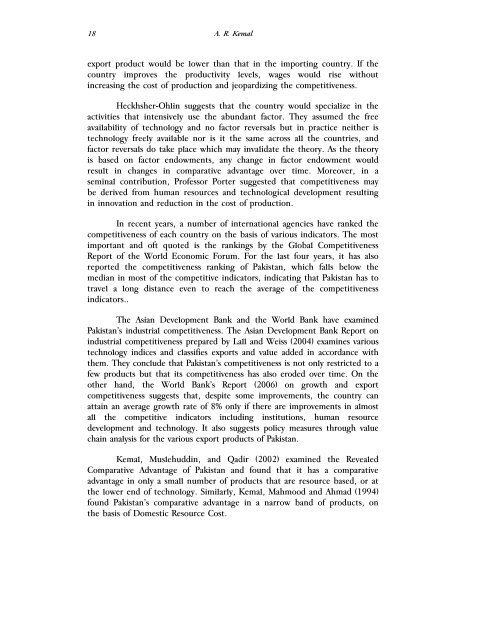Special Edition-07.pdf - Lahore School of Economics
Special Edition-07.pdf - Lahore School of Economics
Special Edition-07.pdf - Lahore School of Economics
Create successful ePaper yourself
Turn your PDF publications into a flip-book with our unique Google optimized e-Paper software.
18<br />
A. R. Kemal<br />
export product would be lower than that in the importing country. If the<br />
country improves the productivity levels, wages would rise without<br />
increasing the cost <strong>of</strong> production and jeopardizing the competitiveness.<br />
Heckhsher-Ohlin suggests that the country would specialize in the<br />
activities that intensively use the abundant factor. They assumed the free<br />
availability <strong>of</strong> technology and no factor reversals but in practice neither is<br />
technology freely available nor is it the same across all the countries, and<br />
factor reversals do take place which may invalidate the theory. As the theory<br />
is based on factor endowments, any change in factor endowment would<br />
result in changes in comparative advantage over time. Moreover, in a<br />
seminal contribution, Pr<strong>of</strong>essor Porter suggested that competitiveness may<br />
be derived from human resources and technological development resulting<br />
in innovation and reduction in the cost <strong>of</strong> production.<br />
In recent years, a number <strong>of</strong> international agencies have ranked the<br />
competitiveness <strong>of</strong> each country on the basis <strong>of</strong> various indicators. The most<br />
important and <strong>of</strong>t quoted is the rankings by the Global Competitiveness<br />
Report <strong>of</strong> the World Economic Forum. For the last four years, it has also<br />
reported the competitiveness ranking <strong>of</strong> Pakistan, which falls below the<br />
median in most <strong>of</strong> the competitive indicators, indicating that Pakistan has to<br />
travel a long distance even to reach the average <strong>of</strong> the competitiveness<br />
indicators..<br />
The Asian Development Bank and the World Bank have examined<br />
Pakistan’s industrial competitiveness. The Asian Development Bank Report on<br />
industrial competitiveness prepared by Lall and Weiss (2004) examines various<br />
technology indices and classifies exports and value added in accordance with<br />
them. They conclude that Pakistan’s competitiveness is not only restricted to a<br />
few products but that its competitiveness has also eroded over time. On the<br />
other hand, the World Bank’s Report (2006) on growth and export<br />
competitiveness suggests that, despite some improvements, the country can<br />
attain an average growth rate <strong>of</strong> 8% only if there are improvements in almost<br />
all the competitive indicators including institutions, human resource<br />
development and technology. It also suggests policy measures through value<br />
chain analysis for the various export products <strong>of</strong> Pakistan.<br />
Kemal, Muslehuddin, and Qadir (2002) examined the Revealed<br />
Comparative Advantage <strong>of</strong> Pakistan and found that it has a comparative<br />
advantage in only a small number <strong>of</strong> products that are resource based, or at<br />
the lower end <strong>of</strong> technology. Similarly, Kemal, Mahmood and Ahmad (1994)<br />
found Pakistan’s comparative advantage in a narrow band <strong>of</strong> products, on<br />
the basis <strong>of</strong> Domestic Resource Cost.

















